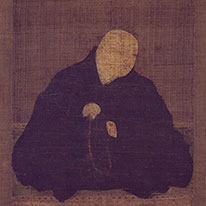Past Exhibitions
- Feature Exhibition: Treasures of Hyakumanben Chion-ji Temple
Part I: Teachings of the Patriarchs - August 7, 2018 - September 9, 2018
The temple of Chion-ji, located at the Hyakumanben intersection on the east side of Kyoto, is one of the seven major Pure Land (Jōdo Shū) Buddhist temples established by the sect's founding priest Hōnen (1133–1212). The name Chion-ji, "Temple of Wisdom and Blessings," came from its second abbot Genchi (1183–1239). Chion-ji is home to numerous important works of art, including the Chinese masterpiece Liu Haichan and Li Tieguai, by Yuan-dynasty painter Yan Hui, which is an Important Cultural Property of Japan. This exhibition includes findings from the Kyoto National Museum's recent inventory of Chion-ji's collections. Enjoy the artistic treasures of Pure Land Buddhism, a religious tradition with deep roots in Kyoto.
Part I: Teachings of the Patriarchs
The Pure Land sect of Buddhism became popular during China's Northern and Southern Dynasties (420–589); but it was the writings of a Tang-dynasty priest named Shandao (613–681) that later inspired the Japanese cleric Hōnen (1133 –1212) to establish a Pure Land sect (Jōdo Shū) in Japan. The Kyoto temple of Chion-ji, which was founded by Hōnen, preserves many important sculptural and painted images of Shandao and other early Pure Land patriarchs. It also houses approximately fifty portraits of its own abbots over the generations, up through the Edo period, suggesting the endurance of Hōnen's Pure Land teachings over the centuries.
Galleries are:
【Gallery 2F-1】Part I: Teachings of the Patriarchs
【Gallery 2F-2】Part II: The Pure Land
【Gallery 2F-3】Part II: The Pure Land
【Gallery 2F-4】Part II: The Pure Land / Part III: Gifted Treasures
【Gallery 2F-5】Part III: Gifted Treasures












